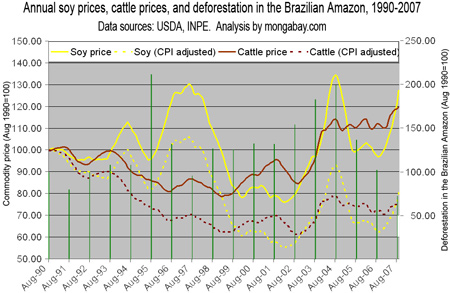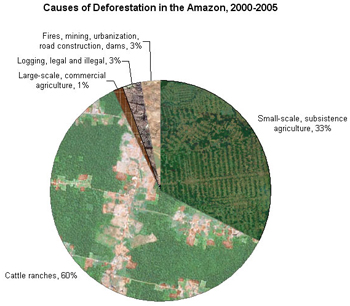Brazil seizes cattle illegally grazing on Amazon forest lands
Brazil seizes cattle illegally grazing on Amazon forest lands
mongabay.com
June 25, 2008
|
|
In an unprecedented move Brazilian authorities seized 3,100 head of cattle found grazing on illegally deforested lands in the Amazon, reports the New York Times. The cattle’s owner had been fined 3 million reais ($1.86 million) in 2005 for illegal forest clearing and had ignored a court order to remove the livestock from the lands.
Carlos Minc, Brazil’s environment minister, said the cattle would be auctioned in two weeks. Proceeds will go to indigenous health initiatives and Fome Zero, the government’s food program for the poor.
In response to a jump in deforestation since last August, earlier this month Minc announced a plan to create a “green barrier” of protected areas in Brazil’s “Arc of Deforestation” in the southern Amazon along with a crackdown on illegal forest clearing in the region. Minc said the effort would include seizure of cattle, grains and timber produced and harvested illegally in the region.
 The recent surge in soy and cattle prices could be driving an increase in forest fires. Annual deforestation figures for the 2007-2008 year will not be released until August of 2008. |
Clearing for cattle pasture is the largest driver of deforestation in the Amazon, accounting for more than two-thirds of annual forest clearing in many years. Traditionally such land has been used for low intensity grazing, primarily as a vehicle for speculating on appreciating land prices, but this is changing. The recent influx of capital, combined with the eradication of foot-and-mouth disease and improved infrastructure, has lead to the emergence of intensive operations with six to eight times the number of cattle per hectare. These trends have spurred Brazil’s rise to become the world’s largest exporter of beef. Today the country has more than 200 million head of cattle and slaughterhouses in the Amazon account for more than 40 percent of production, according to a 2008 study by Amigos da Terra Amazônia Brasileira. 96 percent of growth in country’s herd size since the end of 2003 has occurred in the Amazon.

|
Brazil houses more than 60 percent of the Amazon rainforest, the world’s largest tropical forest. Over the past 30 years nearly one-fifth of the forest area have been cleared, largely for agriculture and cattle pasture. Scientists estimate the forest may be home to one quarter of the world’s land-based plant and animal species as well as the largest population of indigenous people still living in traditional ways.
Related articles
Amazon soy moratorium extended; may be expanded to other products
(6/23/2008) Soy crushers operating in the Brazilian Amazon have extended a two-year-old moratorium on the purchase of soybeans produced on rainforest lands deforested after 2006, reports Reuters.
Amazon beef producer creates eco-certified meat product with help of scientists
(6/8/2008) Independencia Alimentos SA, Brazil’s fifth-largest beef producer, will create an “eco-certified”, branded beef product from the Amazon’s Xingu region. Certification will be based on criteria established by Aliança da Terra, an Brazilian NGO that seeks to improve the environmental performance of ranchers and beef producers in the world’s largest rainforest. The new beef product will include a per-kilo “ecosystem service fee” — calculated with the help of scientists at the Woods Hole Research Center — to facilitate a financial reward for the producer’s environmental stewardship.
Brazil’s new environmental minister blames ranchers for surge in Amazon deforestation
(6/3/2008) Deforestation in the Brazilian Amazon rose significantly in April 2008 according to Carlos Minc, Brazil’s newly appointed environment minister.
Cheap ranch loans may be driving jump in Amazon deforestation
(2/12/2008) Surging deforestation in the Brazilian Amazon may be partly the result of new financial incentives given by state banks such as the Bank of Amazon (BASA), reports Agência de Noticias da Amazônia, a Brazilian newspaper, and the International Tropical Timber Organization (ITTO).
Is the Amazon more valuable for carbon offsets than cattle or soy?
(10/17/2007) After a steep drop in deforestation rates since 2004, widespread fires in the Brazilian Amazon (September and October 2007) suggest that forest clearing may increase this year. All told, since 2000 Brazil has lost more than 60,000 square miles (150,000 square kilometers) of rainforest — an area larger than the state of Georgia or the country of Bangladesh. Most of this destruction has been driven by clearing for cattle pasture and agriculture, often in association with infrastructure development and improvements. Higher commodity prices, especially for beef and soy, have further spurred forest conversion in the region.
Can new loan really bring sustainable cattle ranching to the Amazon?
(3/12/2007) Brazil’s second largest exporter of beef has won approval of a controversial loan from the International Finance Corporation (IFC), the private equity lender of the World Bank, according to a report from the Associated Press. Environmentalists say the deal will drive further deforestation in the biologically rich Amazon rainforest. Cattle ranching is responsible for more than half of forest loss in the region.